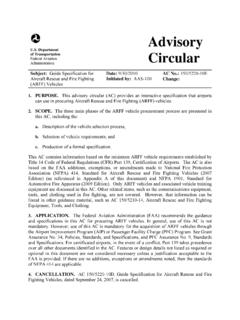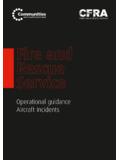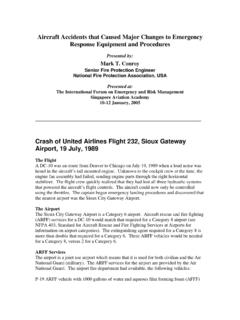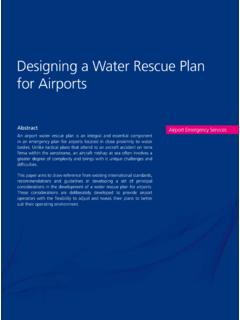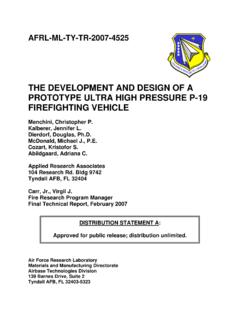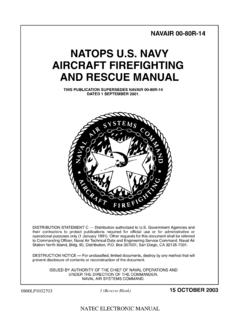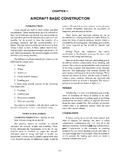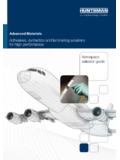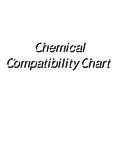Transcription of MISHAP RISK CONTROL GUIDELINES FOR ... - …
1 USAF ADVANCED COMPOSITES PROGRAM OFFICE MISHAP RISK CONTROL GUIDELINESFOR ADVANCED AEROSPACE MATERIALSENVIRONMENTAL, SAFETY, AND HEALTHCONCERNS FOR ADVANCED COMPOSITESP roject Engineer: Lt John M. Olson28 Oct 93SM-ALC/TIECDSN 633-38105201 Bailey LoopComm: (916) 643-3810 McClellan AFB, CA 95652-2514 FAX: (916) 643-04872 TABLE OF CONTENTSM ishap Risk CONTROL GUIDELINES : Part II. Purposepage 4II. Scopepage 4 III. Backgroundpage 5IV. Hazard Assessmentpage Organic Compound/Matrix Hazardspage Smoke and Fume Hazardspage Reinforcement Hazardspage Specific Carbon Fiber Hazardspage Electrical Hazards to Equipmentpage Hazards to the Environmentpage 8V.
2 Introduction to MISHAP Risk Controlpage 9VI. MISHAP Response Guidelinespage Initial Surveypage Responsepage Containmentpage Clean-up and Disposalpage 14 VII. Personal Protective Equipmentpage 15 Equipment Listpage 17 PPE Rules of Thumbpage 18 Appendix 1: Fixant Mixing Procedurespage 19 MISHAP Risk CONTROL GUIDELINES :Recommendations and Action ItemsI. General Recommendationspage Researchpage PPE Equipmentpage Implementationpage Procedurespage Application Equipmentpage Medicalpage Generalpage 28II. Recommended Actionpage 29 Reference Listpage 313 NOTE:These GUIDELINES are only general in nature. Specific actions are aircraft andmaterial dependent.
3 Users should contact specific weapon systemmanagement offices for specific RISK CONTROL GUIDELINES FOR ADVANCED AEROSPACE MATERIALSPart II. PurposeThe purpose of this report is to provide information pertaining to environmental,safety, and health risk CONTROL issues for aircraft mishaps involving advancedmaterials, especially composites. The ultimate goal of this project is to provideinformation for Air Force, DoD, federal, and international policies guiding theprocedures and precautions recommended for personnel involved in all phasesof a composite aircraft MISHAP response, including fire-fighting, investigation,recovery, clean-up, and material ScopeIn order to limit the focus of these GUIDELINES , only post- MISHAP response risksassociated with a significant release of advanced aerospace/ composite materialswill be discussed.
4 It should be assumed that this would occur whenever fire orexplosions accompany a MISHAP involving composite aircraft materials are distinguished from their traditional/commoditycounterparts by their relative increased cost, performance, and materials consist of two or more substances combined to produce amaterial with specific physical characteristics for specialized applications. Forthe purposes of this report, advanced composites are defined as compositematerials applicable to aerospace construction/environments that are comprisedof high-strength, high-modulus reinforcement(s) within a generallyhomogeneous matrix.
5 Yet, because of the extreme diversity of materials andbroad spectrum of applications, no single characterization is are often incorrectly described purely in terms of the reinforcementor fiber ( Graphite, boron composites), without reference to the matrix , matrix material information is an essential aspect of MISHAP riskassessment and will be addressed accordingly. This report will address allmaterial risks, with special emphasis upon carbon/graphite fiber reinforcementand polymer matrix composites (thermoplastic or thermoset) because of theirfire/thermal GUIDELINES are specifically oriented towards aerospace concerns, althoughthe information is widely applicable to other transportation mediums andmishap scenarios.
6 Likewise, the information could be readily adapted to othermilitary, government, or private applications. By focusing on both base- and5command/policy-level needs across all major commands and locations, theseguidelines establish minimum safety and health precautions oriented towardsthe end-users for associated training courses and local aircraft MISHAP responseprocedures/protection requirements. However, these GUIDELINES are notintended to be used independently, but as more of a consolidated guidancesource. Given the strength-to-weight, cost, and performance advantages ofadvanced composite materials, their use for production, repairs, andmodifications will continue to increase.
7 As advanced composites proliferate, sotoo must the level of supporting information, guidance, research, andcooperation among BackgroundTremendous liability, skyrocketing health and disability costs, increasedenvironmental responsibility, and loss potential concerns are the driving forcesin this emerging area. It should be emphasized that composites are comprised ofa complex mixture of materials whose composition, concentration, and toxicityare not always clearly known, especially in a MISHAP environment. Because ofthe unknown hazards, diverse locations, and complex scenarios, a high degree ofprecaution with protective measures is on-going research has often been inconclusive, evidence shows thatburned or exploded components of composite materials DO cause personnelhealth and safety problems IF personnel are not properly protected.
8 Numerousaccounts of both military and civilian response personnel becoming ill or dyingas a result of exposure to toxic gases from the burning plastics/compositematerials have been documented. Respiratory irritation and health problemsfrom inhalation of fiber particulates and dust as well as mechanical irritationfrom dermal contact/abrasion/puncture/sensitization are also noted. Althoughgenerally conflicting in nature, specifically regarding graphite as a "nuisance"dust, some health reports and studies have been accomplished. Regardless oftheir final determinations, all recommend caution and state that unknown healthhazards do Hazard AssessmentIn developing procedures to deal with advanced composite material componentsreleased from burning and burnt aircraft, the hazards must be assessed ascompletely and accurately as possible.
9 Likewise, system and equipmentvulnerabilities must be identified before any protective techniques andprocedures can be applied. Mishaps involving multiple aircraft or in enclosedareas will create a more concentrated and severe environment and should be6treated with greater concern. It shall be assumed that any advanced compositematerial which is intact, as manufactured in the final product, is deemed inert,non-hazardous, and biologically benign. The following hazard information isnot all inclusive, although it does emphasize several key Organic Compound/Matrix HazardsOrganic compounds, including resins, adhesives, and other chemicals, used inthe manufacturing of advanced composite material products are generallyconsidered inert and harmless when undisturbed in the final product.
10 However,when these substances are subjected to the fire, thermal, and energy extremes ofan aircraft crash, these compounds can become unstable, leading todecomposition and chemical reactivity. Resins, such as epoxies, polyimides,phenolics, and thermoplastics, may release harmful or lethal vapors and gasesinto the air when burned. Polymer matrix composites, because of their dominantuse and generally lower temperature constraints are of most concern. Residualsolvent contact from the destroyed composite materials and other heavy orradioactive materials also presents important material health hazards.
